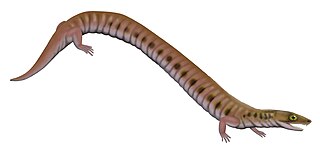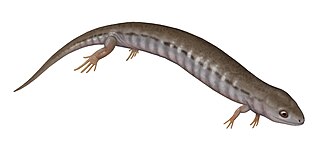
Microsauria is an extinct, possibly polyphyletic order of tetrapods from the late Carboniferous and early Permian periods. It is the most diverse and species-rich group of lepospondyls. Recently, Microsauria has been considered paraphyletic, as several other non-microsaur lepospondyl groups such as Lysorophia seem to be nested in it. Microsauria is now commonly used as a collective term for the grade of lepospondyls that were originally classified as members of Microsauria.

Asaphestera is an extinct genus of a tetrapod described on the basis of fossils from the Carboniferous of the Joggins locality in Nova Scotia, Canada. It was originally described as an undetermined lepospondyl and subsequently classified as a microsaur within the family Tuditanidae. A study published in May 2020 found that specimens referred to Asaphestera represented several unrelated species. Steen (1934)'s original species name Asaphestera platyris was retained for a skull which has been re-evaluated as the earliest known synapsid.

Boii is an extinct genus of microsaur within the family Tuditanidae. It was found in Carboniferous coal from mines near the community of Kounov in the Czech Republic. The only remains of the genus consist of a crushed skull, shoulder girdle bones, and scales, which were similar to microsaurian elements originally referred to Asaphestera. Boii can be characterized by its heavily sculptured skull, thin ventral plate of the clavicles, and a larger number of fangs on the roof of the mouth. For many years the type and only known species, Boii crassidens, was considered to be a species of Sparodus, until 1966 when Robert Carroll assigned it to its own genus.

Batropetes is an extinct genus of brachystelechid recumbirostran "microsaur". Batropetes lived during the Sakmarian stage of the Early Permian. Fossils attributable to the type species B. fritschi have been collected from the town of Freital in Saxony, Germany, near the city of Dresden. Additional material has been found from the Saar-Nahe Basin in southwestern Germany and has been assigned to three additional species: B. niederkirchensis, B. palatinus, and B. appelensis.
Hapsidopareion is an extinct genus of microsaur belonging to the family Hapsidopareiidae. Fossils have been found in the early Permian of Oklahoma.
Llistrofus is an extinct genus of early Permian microsaur within the family Hapsidopareiidae that is known from Oklahoma.
Limnerpeton is an extinct genus of dissorophoidean euskelian temnospondyl within the family Amphibamidae.
Ostodolepis is an extinct genus of microsaur within the family Ostodolepidae. It is known from the Arroyo Formation in Texas.
Micraroter is an extinct genus of microsaur within the family Ostodolepidae.

Rhynchonkos is an extinct genus of rhynchonkid microsaur. Originally known as Goniorhynchus, it was renamed in 1981 because the name had already been given to another genus; the family, likewise, was originally named Goniorhynchidae but renamed in 1988. The type and only known species is R. stovalli, found from the Early Permian Fairmont Shale in Cleveland County, Oklahoma. Rhynchonkos shares many similarities with Eocaecilia, an early caecilian from the Early Jurassic of Arizona. Similarities between Rhynchonkos and Eocaecilia have been taken as evidence that caecilians are descendants of microsaurs. However, such a relationship is no longer widely accepted.
Pariotichus is an extinct genus of gymnarthrid microsaurs from the early Permian of Texas.

Tuditanus is an extinct genus of tuditanid microsaur from the Carboniferous, ~ 306 Ma ago. It was of small size, reaching a length of about 24 cm.

Saxonerpeton is an extinct genus of microsaur of the family Hapsidopareiidae. Fossils have been found from Early Permian strata near Dresden, Germany.

Hyloplesion is an extinct genus of microbrachomorph microsaur. It is the type and only genus within the family Hyloplesiontidae. Fossils have been found from the Czech Republic near the towns of Plzeň, Nýřany, and Třemošná, and date back to the Middle Pennsylvanian. The type species is H. longicostatum, named in 1883. Two species belonging to different genera, Seeleya pusilla and Orthocosta microscopica, have been synonymized with H. longicostatum and are thought to represent very immature individuals.

Brachystelechidae is an extinct family of Early Permian microsaurs. The family was first named by Robert L. Carroll and Pamela Gaskill in 1978, with the only member being Brachystelechus fritschi. Brachystelechus fritschi has since been reassigned to the genus Batropetes. Genera assigned to the family include: Batropetes, from Germany; Carrolla, from Texas; Quasicaecilia, also from Texas; Diabloroter, from the Mazon Creek lagerstätte of Illinois; and Bromerpeton from the Tambach Formation of Germany.

Tuditanomorpha is a suborder of microsaur lepospondyls. Tuditanomorphs lived from the Late Carboniferous to the Early Permian and are known from North America and Europe. Tuditanomorphs have a similar pattern of bones in the skull roof. Tuditanomorphs display considerable variability, especially in body size, proportions, dentition, and presacral vertebral count. Currently there are four families of tuditanomorphs, with two being monotypic. Tuditanids first appear in the Lower Pennsylvanian. Goniorhynchidae, Hapsidopareiidae, and Trihecatontidae appear in the Late Pennsylvanian and Early Permian.
Gymnarthridae is an extinct family of the group Recumbirostra. Gymnarthrids are known from Europe and North America and existed from the Late Carboniferous through the Early Permian. Remains have been found from the Czech Republic, Nova Scotia, Illinois, Texas, and Oklahoma. Previously they were considered tuditanomorph microsaurs.

Ostodolepidae, also spelled Ostodolepididae, is an extinct family of Early Permian tetrapods. Initially they were considered microsaurs, but later were assigned to the group Recumbirostra. Ostodolepids were relatively large, reaching lengths of up to 2 feet (61 cm), terrestrial, and presumably fossorial. Ostodolepid remains have been found from Early Permian beds in Texas, Oklahoma, and Germany.

Tuditanidae is an extinct family of microsaurian tetrapods. Fossils have been found from Nova Scotia, Ohio, and the Czech Republic and are Late Carboniferous in age.

Hapsidopareiidae is an extinct family of microsaurs. Hapsidopareiids are known from the Early Permian of the United States and possibly Germany and the Czech Republic.













